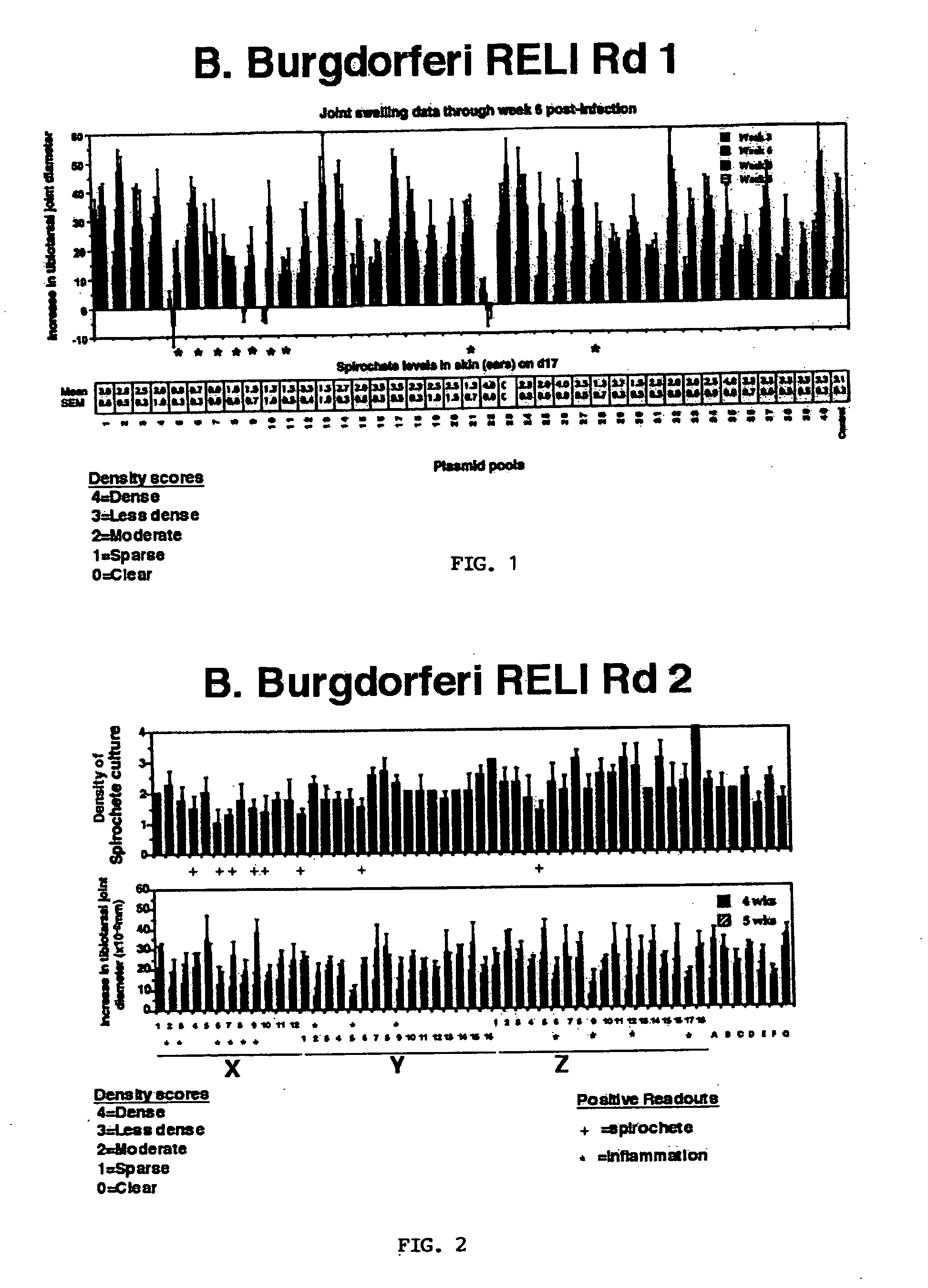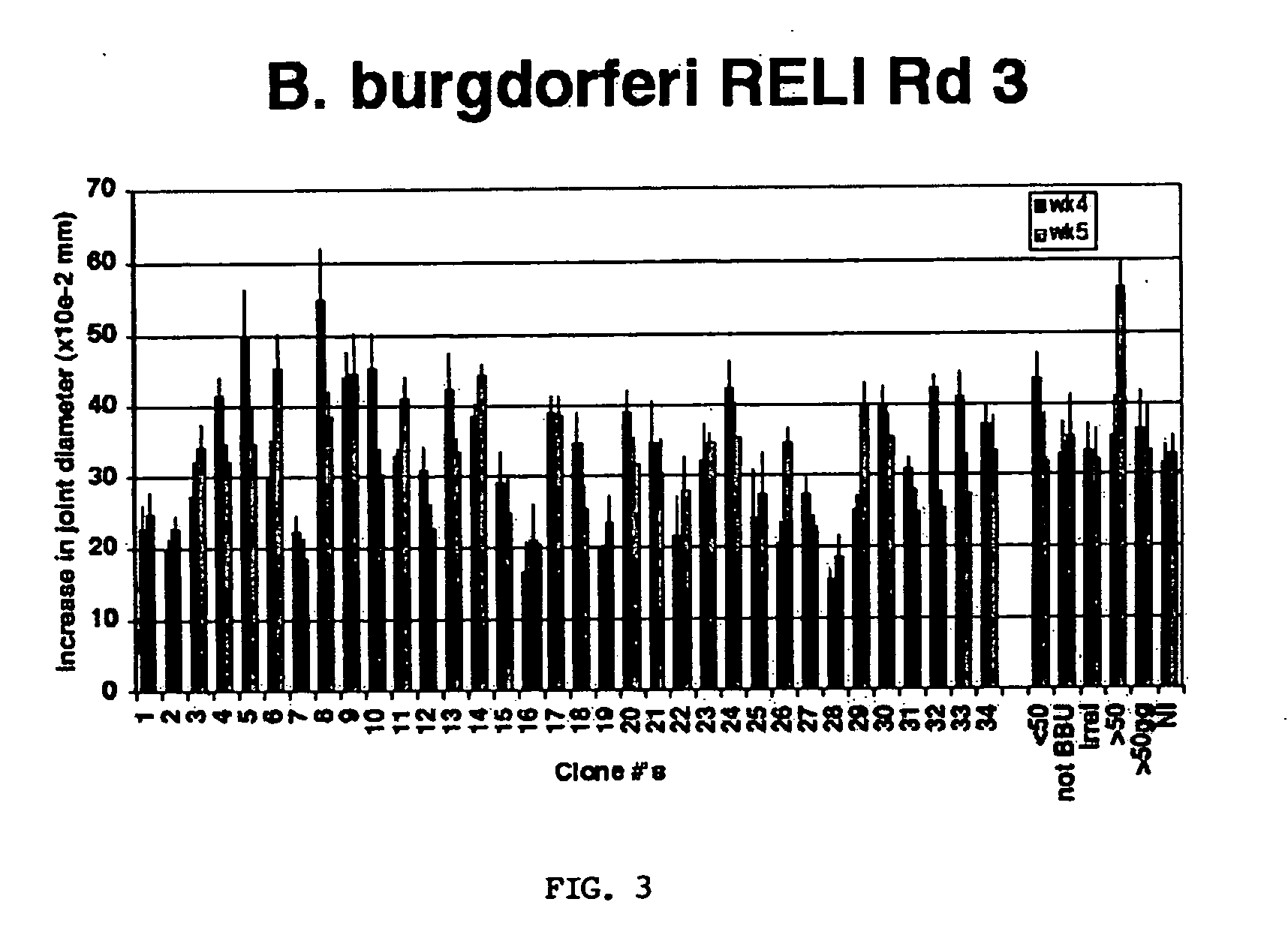Methods and compositions for vaccination comprising nucleic acid and/or polypeptide sequences of the genus Borrelia
a technology of nucleic acid and/or polypeptide sequences, applied in the field of vaccines, immunology, bacteriology, molecular biology, etc., can solve the problems of inability to readily produce vaccines, inability to develop vaccines for many years, and inability to easily produce vaccines
- Summary
- Abstract
- Description
- Claims
- Application Information
AI Technical Summary
Benefits of technology
Problems solved by technology
Method used
Image
Examples
example 1
Construction of a Borrelia burgdorferi Expression Library.
[0276]Borrelia burgdorferi (BBU) stock isolate 910255, obtained from Dr. Steven Nickell, was originally isolated from a wild mouse. The bacteria were grown at 33° C. under anaerobic conditions, and genomic DNA was isolated by published procedures (Hinnebusch and Barbour, 1992). The library production protocol was similar to that previously described to generate HIV and SIV random expression libraries (Sykes and Johnston, 1999 and Sykes et al., 2002). Briefly, Borrelia DNA was physically sheared with a nebulizer (Glas-Col, Terre Haute, Iowa.), and stripped ends were mended with Klenow and T4 polymerase Fragments from 300 to 800 base pairs (bp) were size-selected by electrophoresis through a 1.5% agarose TRIS-borate gel, then excised and electroeluted. To convert the blunt DNA to sticky ended fragments for cloning, Bg / II adaptors were designed. Two oligonucleotides (15-mer: GATCTGGATCCAGGC (SEQ ID NO:140), 11-mer: GCCTGGATCCA ...
example 2
Borrelia burgdorferi Expression Library Immunization and Challenge, Round 1
[0279] The 40 sub-library mixed-DNA samples were combined with a plasmid encoding murine granulocyte-macrophage colony-stimulating factor (GM-CSF) at {fraction (1 / 10)}th library DNA dose in phosphate buffered saline (PBS). These inocula were intramuscularly (i.m.) injected into 40 groups (4 mice per group) of 6-week old C3H / NeH mice. Each mouse received each 50 μg of Borrelia library and 5 μg of pCMViGMCSF (Smooker et al., 2000, and Xiang and Ertl, 1995), distributed between four sites, left and right quadricep and tibialis anterior muscles. The mice were administered boosts with the identical inocula at weeks 8 and 12. The vaccinees were challenged subcutaneously with 100 μl of a B. burgdorferi inoculum (105 organisms) 2 weeks after the last immunization, and then monitored for infection and disease based on two readouts over the course of 6 weeks. To assess infection, ear skin samples were removed 17 days ...
example 3
Array Analysis of the Expression Library, Round 2.
[0280] The components for the second round of sib testing were retrieved from the nine nitrocellulose filter-stocks that corresponded to the nine positively scored sublibrary inocula of round 1. The filters were replica-plated onto fresh bioassay trays and colonies were regrown. Single, original transformants were now available to be transferred into a robotic format. Toothpicks were used to inoculate individual microtiter-plate cultures containing HYT freezing media (1.6% Bacto-tryptone, 1.0% Bacto-yeast extract, 85.5 mM NaCl, 36 mM K2HPO4, 13.2 mM KH2PO4, 1.7 mM Sodium citrate, 0.4 mM MgSO4, 6.8 mM ammonium sulfate, 4.4% wt / vol glycerol) supplemented with 75 μg / mL ampicillin, and were grown overnight at 37° C. Growth and storage of the libraries as mini-cultures served to permanently maintain the original library complexity. Using a stamping tool, 20×20 cm LB-carbenicillin / lincomyocin agar plates were inoculated with a set of the ...
PUM
 Login to View More
Login to View More Abstract
Description
Claims
Application Information
 Login to View More
Login to View More - R&D
- Intellectual Property
- Life Sciences
- Materials
- Tech Scout
- Unparalleled Data Quality
- Higher Quality Content
- 60% Fewer Hallucinations
Browse by: Latest US Patents, China's latest patents, Technical Efficacy Thesaurus, Application Domain, Technology Topic, Popular Technical Reports.
© 2025 PatSnap. All rights reserved.Legal|Privacy policy|Modern Slavery Act Transparency Statement|Sitemap|About US| Contact US: help@patsnap.com


